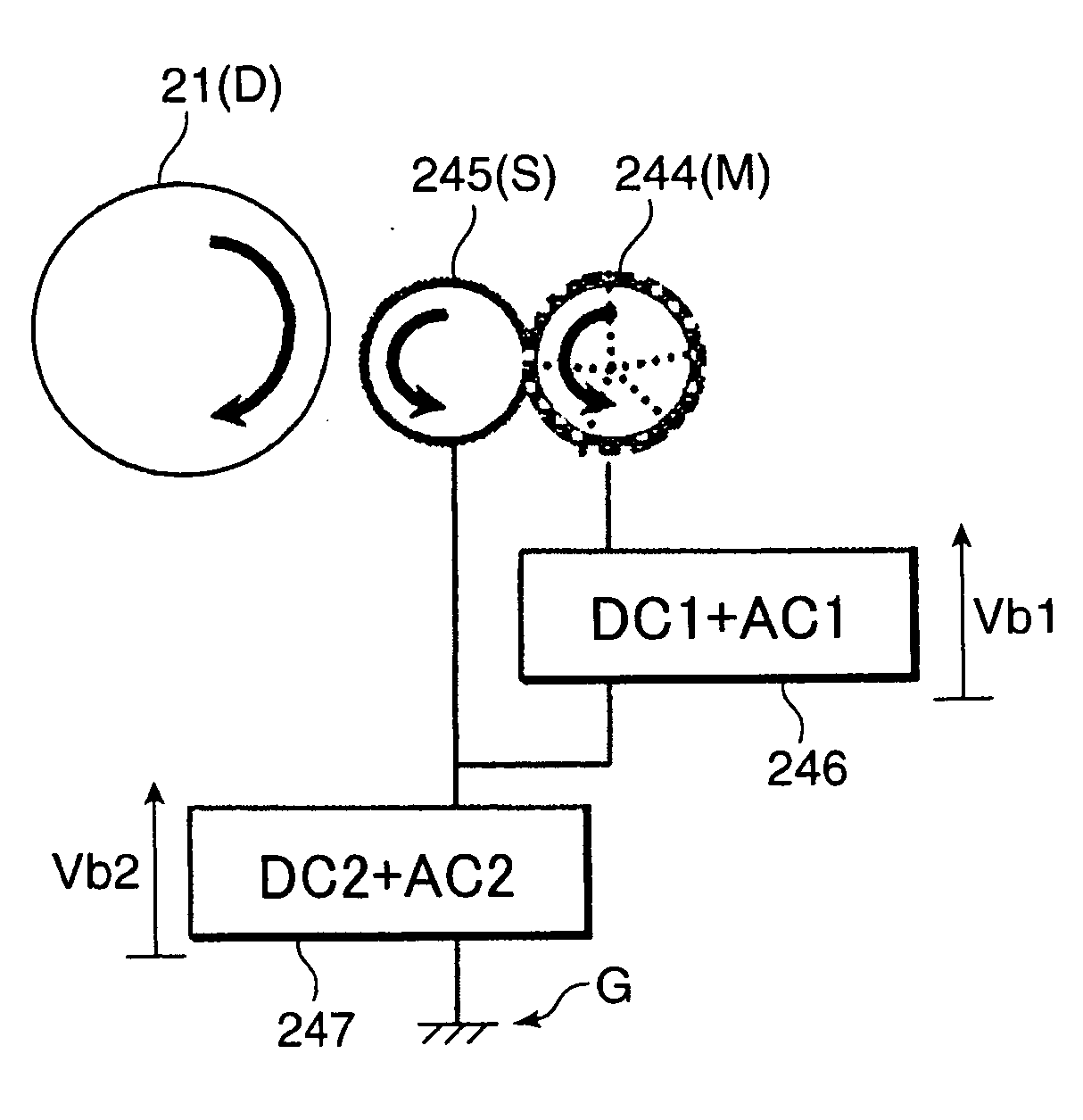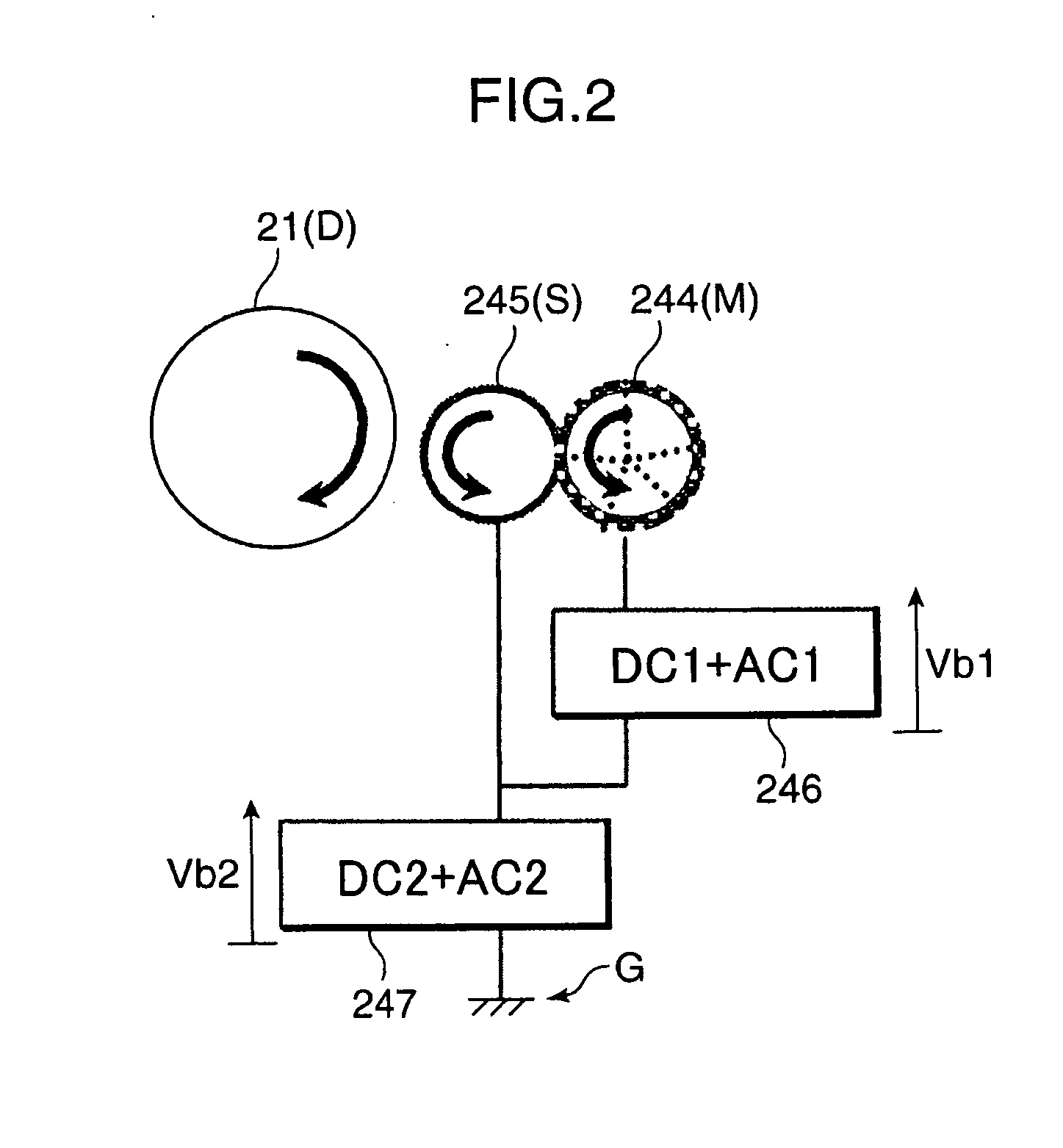Image forming apparatus
a technology of image forming apparatus and forming chamber, which is applied in the direction of electrographic process apparatus, instruments, optics, etc., can solve the problems of complex charge control of toner, large apparatus, and high surface area, and achieve suppression of image density defects, fogging, and toner scattering.
- Summary
- Abstract
- Description
- Claims
- Application Information
AI Technical Summary
Benefits of technology
Problems solved by technology
Method used
Image
Examples
first embodiment
[0040]Hereinafter, printers as examples of an image forming apparatus according to the present invention are described with reference to the accompanying drawings. FIG. 1 is a schematic construction diagram of an example of a printer according to a first embodiment. As shown in FIG. 1, the printer 1 is a so-called tandem image forming apparatus and image forming units 2M, 2C, 2Y and 2K of different colors, i.e. magenta (M), cyan (C), yellow (Y) and black (K) are arranged side by side in a printer main body.
[0041]The image forming units 2M, 2C, 2Y and 2K (an assembly of these is called an “image forming assembly 2”) are for forming (printing) a color image on a sheet and are each provided with a photoconductive drum 21 (latent image bearing member) made of, for example, amorphous silicon (a-Si), a charger 22, an exposing device 23 and a developing device 24 arranged around this photoconductive drum 21.
[0042]The charger 22 uniformly charges the outer surface of the photoconductive dru...
second embodiment
[0099]In a second embodiment, the above printer 1 was constructed (set) to satisfy the following conditions (development conditions). Specifically, an a-Si drum made of the above a-Si photoconductor was used as the photoconductive drum 21; the photoconductive drum diameter was set to 30 mm, the developing roller diameter to 20 mm and the magnetic roller diameter to 25 mm.
[0100]The circumferential speeds of these were as follows.
Photoconductive drum 21:300 mm / secDeveloping roller:450 mm / secMagnetic roller:675 mm / sec.
[0101]The developing roller 245 used had the outer surface thereof made of an aluminum base material and had an alumite processing applied to the outer surface of the aluminum base material (coated with the silicon modified urethane resin in the first embodiment). A gap (spacing) between the magnetic roller 244 and the developing roller 245 was 350 μm.
[0102]Bias voltages applied to the magnetic roller 244 and the developing roller 245 were as follows. Further, the wavefor...
third embodiment
[0112]Although Duty(slv)=50% and Duty(mag)=65% in the second embodiment, the setting is not limited thereto and any setting to satisfy the above condition, i.e. 100(%)−Duty(mag)1), (AC2) in this case are shown in FIG. 9.
[0113]In this case as well, it was empirically found that the half width difference of the charge number distribution of toner could be set to 0.8 (10−10 C / m) or smaller or that the half width difference and the peak position difference could be respectively set to 0.8 (10−10 C / m) or smaller and 1.0 (10−10 C / m) or smaller.
[0114]Results in the case of forming images on sheets using the image forming apparatuses according to these first to third embodiments are summarized in a table shown in FIG. 5. FIG. 5 shows experimental results obtained for the first to third embodiments as Examples 1 to 3. Other examples according to the present invention are shown as Examples 4 to 8. In this table are also shown Comparative Examples 1 to 4 according to prior arts. Specific evalu...
PUM
 Login to View More
Login to View More Abstract
Description
Claims
Application Information
 Login to View More
Login to View More - R&D
- Intellectual Property
- Life Sciences
- Materials
- Tech Scout
- Unparalleled Data Quality
- Higher Quality Content
- 60% Fewer Hallucinations
Browse by: Latest US Patents, China's latest patents, Technical Efficacy Thesaurus, Application Domain, Technology Topic, Popular Technical Reports.
© 2025 PatSnap. All rights reserved.Legal|Privacy policy|Modern Slavery Act Transparency Statement|Sitemap|About US| Contact US: help@patsnap.com



